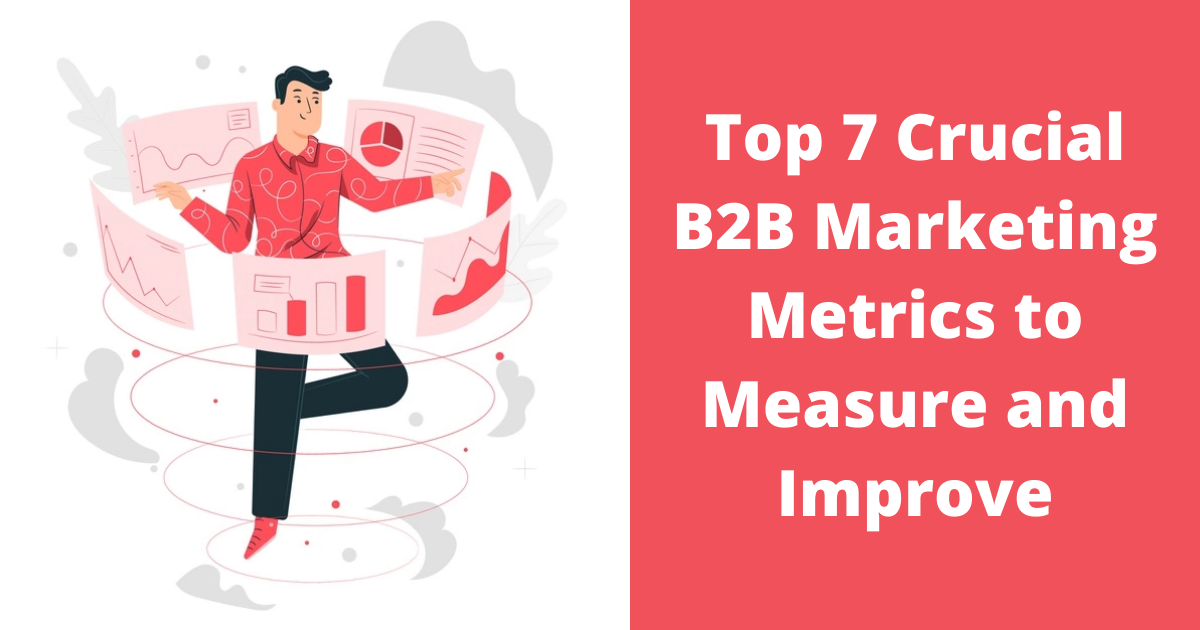Top 7 Crucial B2B Marketing Metrics to Measure and Improve

What criteria do you use to evaluate the performance of your B2B marketing campaign or what are the B2B Marketing Metrics you take into consideration? As CEOs throughout the world view marketing as a growth driver, they have become more critical of the effectiveness of all marketing operations. Leaders are searching for more than just engagement statistics and quality leads.
Marketers are constantly under pressure in today’s data-driven B2B world to get the most out of their investments and efforts. As a result, measuring the performance of your B2B marketing is crucial.
A few marketing measures might help you draw quantified insights into campaign performance. This exercise will reveal how your marketing strategies are affecting your company’s growth and report on their success or failure.
Every seasoned B2B marketer understands that launching a new campaign is a risky proposition. At times, it feels more like an art than a science to tune in to the goals and objectives of possible future customers and produce material that truly attracts their attention. However, once your material is out there, you can assess how well it is achieving your marketing objectives. The key is to understand what B2B Marketing metrics to look for and how to measure them.

According to studies, roughly half of all marketers simply use the most basic data to assess the effectiveness of their efforts. That could be one of the reasons why roughly 70% of B2B material goes unused since it doesn’t align with what buyers are looking for. If customers aren’t noticing, connecting with, and moving closer to making a purchase, all the time, labor, and ingenuity that a marketing team puts into content production is a howl into the void.
You can create more effective campaigns, budget more accurately, and calculate your ROI more accurately with the right metrics. So, what are the most appropriate metrics? It depends on the problem you’re trying to solve.
Marketers may be especially interested in program metrics. They show how effective your content is, where your leads are coming from, and how trustworthy your data is. Revenue metrics, on the other hand, maybe what you need to look at if you need to justify your presence to the C-suite. These figures can show you how much money and profit your marketing efforts are generating.
Top 7 Crucial B2B Marketing Metrics to Measure and Improve
Here are a few B2B Marketing Metrics that every B2B marketer should monitor to see if their efforts are paying off:
1. Website Traffic
The number of individuals that visit your website is an important metric for determining whether or not your SEO techniques are working. Website traffic is a metric you can influence if your marketing and SEO initiatives are bringing the right people to your site. Google Analytics is a fantastic tool for tracking traffic. It provides webmasters with traffic statistics, such as the number of visitors and their origins.
For example, if you’re running different social media marketing efforts, the program will inform you which ones are working and which ones aren’t. User information such as audience geography, viewer time spent on a website, traffic sources, and bounce rate can also be measured using Google Analytics.
2. Marketing Qualified Leads (MQLs)
Marketing Qualified Leads are those who have expressed interest in your product by completing a form or downloading a whitepaper. The criteria for distinguishing MQLs from SQLs (Sales Qualified Leads) differ from company to company. MQLs are further up the funnel, less ready to convert, and will most likely need more exposure to marketing content before they’re ready to be handed over to the sales team.
Scoring leads to measure their quality goes hand in hand with separating your MQLs from your SQLs. The likelihood of a lead becoming a client at some time in the future is used to assign a score. MQLs from a company that closely resembles your normal customer profile is of higher quality than leads from a completely another field. Identifying MQLs also allows you to calculate the cost per MQL generated by each campaign.
3. Revenue Contributed

When it comes down to it, brand awareness is nice, but it doesn’t pay the bills. If customers don’t buy your goods, it doesn’t matter how many leads visit your website or how many activities they do to signal their interest. Someone in the C-suite will want to know the actual ROI for your marketing efforts and money at some time.
It can be difficult to create attribution models that appropriately quantify the ROI of specific marketing activities. It’s occasionally important to take a step back, look at the broad picture, and make the required decisions regarding how your marketing initiatives are adding to income. A multi-touch attribution strategy based on the correct software tools can be extremely useful in this situation.
4. Conversions per Activity
Getting website traffic is excellent, but there’s a big difference between getting people to click on an attractive link or visit an interesting website and really getting people to look at your product and go down your sales funnel. You may sort the leads from the looky-loos by counting the number of conversions per activity.
You may track this KPI using Google Analytics by creating landing pages and confirmation pages. You’ll be able to identify how many people took a given activity after being sent to your website through your marketing efforts this way. For example, a brilliant viral ad could bring thousands of people to your website, but only fifty of them might complete out the registration form for product and pricing information. Those figures are crucial for marketers to know.
5. Cost per Lead
If obtaining leads is the end goal, one of the most crucial factors to consider is how much each one costs. You can see how effective each marketing channel is at delivering potential customers to you by tracking this KPI across different marketing channels.
The greatest tools for measuring this metric are Google Ads and, once again, Google Analytics. When the costs per lead for different marketing channels are vastly different, it indicates that one of them is functioning significantly more efficiently than the others. Smart marketers want to know where they should spend their time and money.
6. Engagement as Clicks
Counting clicks is a simple but efficient approach to determine how well a piece of content attracts and retains a viewer’s attention. Whether those clicks lead to your website or a third-party site like a social media platform, they can act as indicators of brand awareness and purchasing intent.
Simply defined, content that receives clicks is doing its job, but content that receives no clicks is a waste of time in your marketing strategy. If your audience is saying “no thanks” to the links to your content, you can’t even begin to think about lead scoring or conversions. Quantifying engagement in terms of clicks is an important first step in determining whether or not your marketing efforts are effective.
7. Marketing Influenced Customers

In an ideal world, all of your consumers would come from your marketing department’s efforts. Unfortunately, this isn’t the case. But that doesn’t rule out the possibility that your efforts aided in their progression along the buyer’s journey. Your marketing team can still help close a transaction by providing instructive content and nurturing programs, even if your programs didn’t generate the lead.
This metric is similar to marketing-generated leads, but it goes a step further. Examine the number of leads converted in a specific time period to arrive at this figure. Then figure out how many of those leads responded to your marketing efforts at some point. The percentage of marketing-influenced consumers is then calculated by dividing the total number of converted leads by the percentage of marketing-influenced customers.
Conclusion
In the end, your marketing goals will determine what to measure, but the bottom line will always be the bottom line. Revenue metrics are always the deciding factor in whether or not a B2B marketing strategy was worthwhile. It’s critical to examine KPIs periodically and observe how they’re changing over time once you’ve figured out what you’re looking for and how to assess them. Your relevant KPIs will tell you if you’re accomplishing your goals and help you make smarter decisions about when to modify, recalibrate, or shift course, regardless of how big or small your marketing team is. You can launch and manage your B2B marketing campaigns with confidence, knowing that you’re getting the results you want thanks to dependable, relevant data.
